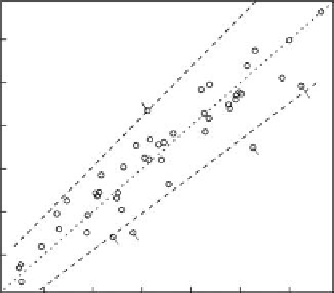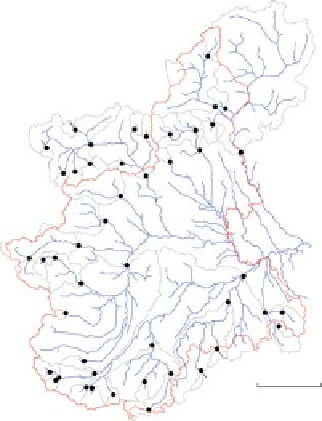Geography Reference
In-Depth Information
Figure 5.12. Mean annual runoff
estimated from regressions vs.
observations. The dashed lines
correspond to the 90% prediction
intervals. The map shows the outlets
of 47 catchments in north-western
Italy. Adapted from Viglione et al.
(
2007a
).
1600
44
1400
43
44
43
39
1200
39
1000
800
35
34
600
600
800
1000 1200
Q
A
(mm/yr)
1400
1600
35
50 km
34
Figure 5.13. Coef
cient of variation
of annual runoff versus mean annual
runoff. Dashed line relates to
Australia and Southern Africa
(ASA), solid line relates to the rest of
world (RoW). From McMahon et al.
(
2007b
), Koster and Suarez (
1999
).
10
ASA
3
1
Kalinin
RoW
0.3
0.1
1
10
100
1000
10000
Mean annual runoff (mm/yr)
indicated that arid (less rainy) catchments are characterised
by more variability.
Figure 5.13
shows the results of
applying this approach to a global data set, stratified into
Australia and Southern Africa and the Rest of the World
(McMahon et al.,
2007b
). The CV of annual runoff in
Australia and Southern Africa is significantly higher than
the rest of the world, for a given mean annual runoff.
Mean annual runoff
Budyko-type models
Budyko-type models offer the
potential to estimate mean annual actual evaporation from
the aridity index and precipitation without calibration.
Mean annual runoff is then estimated as the residual of
precipitation and evaporation. Budkyo-type models
include: Schreiber (Schreiber,
1904
), Ol
'
'
dekop (Ol
dekop,
-
1911
), Turc
Pike (Turc,
1954
; Pike,
1964
; Milly and
Dunne,
2002
), Budyko (Budyko,
1974
), Fu (Fu,
1981
;
Zhang et al.,
2004
; Yang et al.,
2007
); Choudhury
Yang
(Choudhury,
1999
; Yang et al.,
2008
), Zhang two-
parameter model (Zhang et al.,
2001
), and a linear model
by Potter and Zhang (
2009
). These models are driven by
the aridity index, and they do not use explicit conceptual-
isations of catchment processes. They typically include one
parameter, treated as fixed and not necessarily related to
-
5.3.2 Index methods
Index methods assume that the locally scaled signature
of interest, or some functional form of it, is the same for
all catchments in the group, which is called homoge-
neous if it fulfils this assumption. In the following, index
methods for mean and variability of the annual runoff
are discussed.


































































































































































































































































































































































































































































































































































































































































































































































































































































































































































































































































































































































































































































































































Search WWH ::

Custom Search